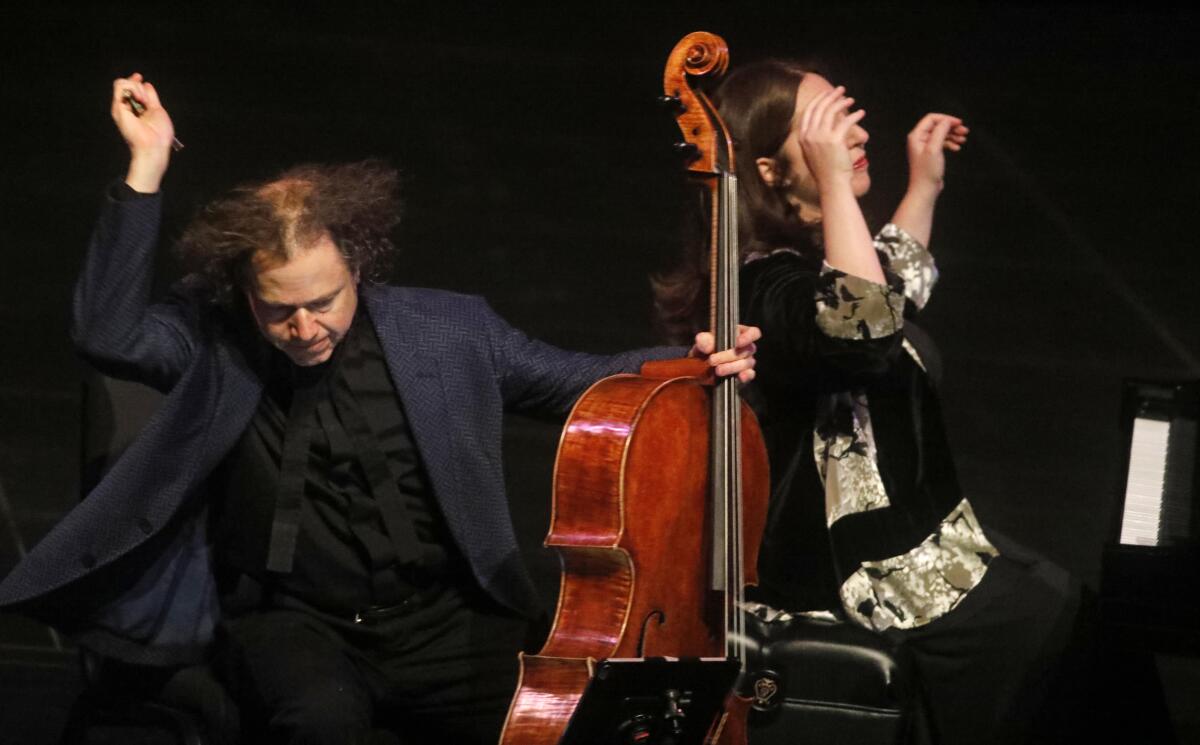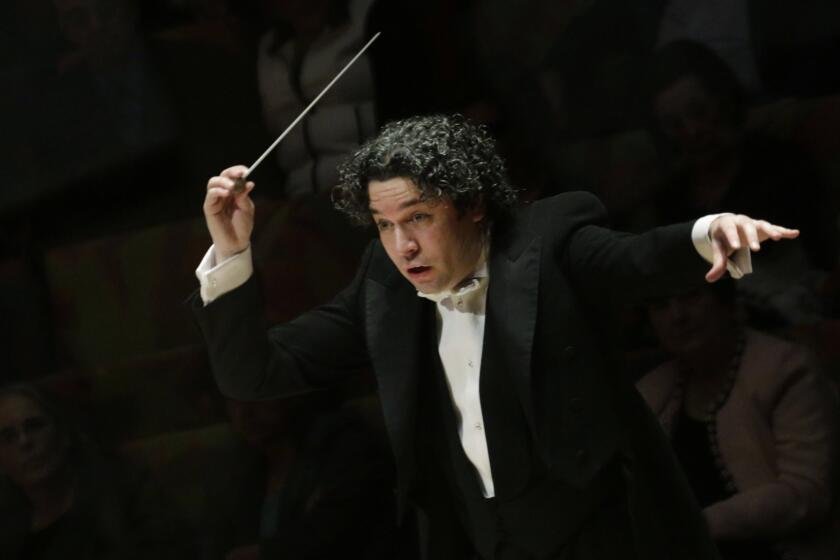Commentary: Beethoven 2020: The 250th birthday tributes start, with mixed results

“Anything goes,” John Cage liked to say, “but that doesn’t mean you can do anything you want.” Or does it?
The White House’s position on the matter has become a national debate. Silicon Valley seems to think it’s OK to try anything without first determining the consequences.
So let’s ask Beethoven. He’s been around. He turns 250 in December. You’ll be hearing a lot from him between now and then, with everyone wanting to get into the big birthday act.
Getting into the act means, of course, programming, recording, finding inspiration in and capitalizing on Beethoven’s music. But it means something else as well. The only way to ultimately find meaning in Beethoven’s genius is to consider what he says to us as we see ourselves — to pair our music with his. But that then brokers the question of what goes with what. Can we do what we want?
Last week at the Wallis Annenberg Center for the Performing Arts, cellist Matt Haimovitz and pianist Simone Dinnerstein paired Beethoven cello sonatas with solo works by Philip Glass. A few nights later at Monday Evening Concerts, the series founded eight decades ago on the premise that both long-forgotten early music and new music are to a modern audience unknown and thus equally new, premieres were interspersed with pieces by old guys few of us had ever heard of.
Meanwhile, on Sunday night, a young German organist, Christian Schmitt, made his Walt Disney Concert Hall debut in a recital that, as organ recitals typically do, crossed centuries, although in this case with a strong nod in Bach’s direction.
It is not easy to know what works with what or why. Contrast can be welcome and sameness not. And vice versa. Sometimes balance matters, helped along by a vague, nondomineering theme, as in Schmitt’s glorious recital. Sometimes the difference is illuminating, as it was Monday at Zipper Hall. Sometimes composers lock heads, as Glass and Beethoven did at the Wallis.
I doubt that Dinnerstein and Haimovitz intended to cut Beethoven down to size quite the way they did in what they called a “Then and Now” program. Their Glass was gripping, but in his presence, the last two of Beethoven’s five cello sonatas were no more shocking than, to paraphrase Cole Porter in the olden days, a glimpse of stocking.
But it’s Bach who knows anything goes. The four movements from Glass’ Partita No. 2 that Haimovitz played were infused with the intensity of sound of Bach’s solo music. Dinnerstein brought the sensuous mad rush of sonority to Glass’ “Mad Rush” that has made her famous performances of Bach’s “Goldberg” Variations a popular sensation. In both cases, this felt like an immersive sonic nowness into which we enter.
Beethoven, though, for all his own sonic nowness in harmonies never before heard, in trills that move music outside of drama, nevertheless operates on a dialectic that here seemed of another age, rather than ageless. Ironically, the use of plush modern instruments proved a detriment. Haimovitz has recorded the sonatas with period instruments, which Beethoven drove to extremes.
With his contract expiring at the end of next season, the Los Angeles Philharmonic’s beloved conductor, Gustavo Dudamel, signs on for five more years.
In fact, Bach, considered a conservative in his own time, proved the greater visionary again in Schmitt’s recital, which began with an elegant Schumann fugue based on Bach’s name and ended in a spectacular Reger fugue, also on the notes B (B flat in German notation), A, C, H (B natural). In between, there were pieces by Bach and contemporary ones by Arvo Pärt (“Annum per Annum”) of otherworldly minimalism and Toshio Hosokawa (“Cloudscape”), an ethereal soundscape.
All of this fit together in considerable part because of Schmitt’s winning sense of grace. Piece after piece, each in its own way grew from delicate colors to glorious rainbows of organ sonorities, making the program a garden of blooms.
The Monday Evening Concerts program took a novel approach by dividing into mirrored halves. It began with a new piece by Trevor Baca, “Fabergé Investigations,” in which an ensemble makes fragile, indistinct instrumental sounds meant to evoke a strange instance of the jeweled eggs lost in the Russian Revolution.
That morphed, with some background electronic effects — and the interruption by an audience member who walked out, announcing that this wasn’t music — into Josh Lee performing an 18th century viola da gamba sonata by Carl Friedrich Abel. That then morphed into a performance of Caroline Shaw’s “Entr’acte,” an entrancing deconstruction of Baroque music performed by an outstanding ad hoc string quartet of recent UCLA grads.
After intermission, the progression was from Shaw’s recent string quartet “Ritornello 2.sq.2.j.a,” to an intriguing investigation into the Monteverdi “L’Orfeo,” to another obscure viola da gamba work (Philip Harquart’s Suite in D Minor) to the premiere of another big Baca ensemble piece.
Like his “Fabergé,” Baca’s “Harmony” was conducted by the Monday Evening Concerts’ artistic director, Jonathan Hepfer. Like everything on the program, it was brilliantly performed. The instrumental sounds were again edgy, as though we were back to the evening’s beginning. But “Harmony” also used a spoken text written by music critic, novelist and librettist Paul Griffiths (who once wrote the memorable MEC program notes) and declaimed by Paul Holdengräber.
In “Harmony,” we were not back to the beginning. We weren’t someplace entirely new, either. We straddled instead, not quite sure where.
Griffiths’ text, much like that of Samuel Beckett, alluded rather than announced. There is a narrator. There is a girl. There is a band. There is a sea. There is silence where there should be sound. “You feel you’ve left the normal world,” the narrator says. As for “Harmony”: “Not yet.”
Baca’s indefinable sounds were the indefinable silences. A dense jungle of scrapes, fragments of songfulness and evaporating explosions insinuated a harmony that is not yet but may be coming.
In Griffiths’ latest novel, “Mr. Beethoven,” the composer lives on and winds up in Boston; it will be published in April. The composer brings his time, his temperament and his sense of democracy to us. But he can’t possibly fit in.
The challenge of Beethoven 250 will be to retain a Beethoven who is among us but refuses to fit in. He must be a Beethoven who retains the ability to help us leave the normal world, not the Beethoven who assures that this is the way the world must be.
Anything goes, but only if we watch our step.
More to Read
The biggest entertainment stories
Get our big stories about Hollywood, film, television, music, arts, culture and more right in your inbox as soon as they publish.
You may occasionally receive promotional content from the Los Angeles Times.












